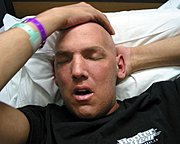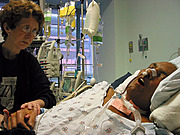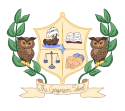
These pictures are a photo essay of my brother, Marc Gregerson, and his battle with lymphoma. Marc was 10 months older than me, and was adopted by my parents (Linda and Dave) before I was born. They lived in Minneapolis, Minnesota.

Marc and I grew up together in Minneapolis, attending the Minneapolis public schools (including South High School). We lived in Prospect Park most of that time.
He and I both moved to California with our Mom around 1988, but while I returned to Minneapolis, he started a family in the Palm Springs area. He was living with his wife, daughter, and two step-sons in Morongo Valley, California, when he developed his first signs of lymphoma: painless lumps in his neck. He mentioned them to his doctor at the time, and was told not to worry, his white blood cell count was normal so he did not have an infection (which is true -- he had cancer).

Some time later, a lymph node in my brother's
chest grew so large it impaired his breathing.
When it became bad enough, his wife took him to
the emergency room. He was diagnosed with Hodgkin's Disease
in August of 2000. It was stage 3 (out of 4),
but his chances of recovery were still favorable
(perhaps somewhat better than 50/50).
 He received chemotherapy for six months,
during which time he was (surprisingly)
still able to work as a long-haul trucker
(working for Swift out of Oxnard, CA.).
He received chemotherapy for six months,
during which time he was (surprisingly)
still able to work as a long-haul trucker
(working for Swift out of Oxnard, CA.).

When his first round of chemo was completed,
his follow-up PET scan looked good (at first).
There were no obvious tumors. Around that time
he lost his job (and his health insurance), and
so he postponed getting the
consolidation radiation treatment he needed.
 He found new work, driving a cement mixer for
AAA. After waiting for his health
insurance there to kick in, he saw a radiologist.
This was three months later, and she said he
was not a candidate for consolidation radiation
treatment -- upon closer inspection
of Marc's PET scan, his cancer was not gone.
He found new work, driving a cement mixer for
AAA. After waiting for his health
insurance there to kick in, he saw a radiologist.
This was three months later, and she said he
was not a candidate for consolidation radiation
treatment -- upon closer inspection
of Marc's PET scan, his cancer was not gone.
Marc tried another course of chemotherapy,
called "mini-beam". He developed intense pain, and
went into a coma. He was admitted to Desert
Hospital in Palm Springs, and there was
no medical explanation (for this or several
chemotherapy-related neuropathies yet to come).
 Note that this is not a normal side-effect of
chemo, my brother's case was unusual.
Note that this is not a normal side-effect of
chemo, my brother's case was unusual.
The coma required the chemo to be stopped. Due to the severity of my brother's illness, and the diminishing chances of recovery, he was considered for high-dose chemotheraphy with a peripheral blood stem cell transplant (PBSCT) at UCLA. Marc was accepted, and scheduled to go there in early January of 2002.
Marc had a central-line catheter installed in
his chest, and was started on Neupogen.
 He received cytoxan as preperatory
chemotherapy in advance of going to UCLA
for pheresis, the harvesting of his own
stem cells for later transplant back to him
(an autologous transplant, where the donor
and recipient are the same). The cytoxan
put Marc in a second coma, and later he
was rushed to the ER after having seizures.
He received cytoxan as preperatory
chemotherapy in advance of going to UCLA
for pheresis, the harvesting of his own
stem cells for later transplant back to him
(an autologous transplant, where the donor
and recipient are the same). The cytoxan
put Marc in a second coma, and later he
was rushed to the ER after having seizures.
 This is highly unusual. It was suspected that
the chemo had passed the blood-brain barrier
or some other anomaly was now occuring with
each round of chemo Marc got.
This is highly unusual. It was suspected that
the chemo had passed the blood-brain barrier
or some other anomaly was now occuring with
each round of chemo Marc got.
The high-dose chemotheraphy treatment Marc got
was, frankly, grueling.
It involved high-dose radiation (painless), but
the chemo causes very painful mucositis, which
makes taking anything by mouth physically impossible
for a period of time.
 In my brother's case, he also developed neuropathy,
including dementia and paranoia (this is unique to him,
highly unusual).
In my brother's case, he also developed neuropathy,
including dementia and paranoia (this is unique to him,
highly unusual).

My brother survived this treatment, and was discharged to the Tiverton House (across the street from UCLA) for observation while he continued to recover. He eventually went home, and soon travelled back to Minneapolis to see some old friends and relatives. He was able to meet his biological Mother for the first time, stay with his Grandmother, and enjoy himself.
In less than a year, he developed back pain, which turned out to be coming from a tumor in his pancreas.

The lymphoma had returned. It was deemed to be an agressive case, especially for Hodgkin's Disease, which is often survivable. I knew from my own reading that each time the cancer returned, his odds of recovery were getting worse. Hospice was now an legitimate option. There was one final treatment with at least some chance of "significantly prolonging" Marc's life, a bone marrow transplant.

Marc's own stem cells had been used for his stem-cell transplant. His bone marrow could not be used (I believe it was too weakened by the chemo he already received, or the cancer was believed to be in the marrow). A search for a matching donor was done, and a match was found ("thank you" to the anonymous stranger who made the donation).

Marc's system could not handle another high-dose chemo treatment, but he could get a weaker regimen. The expected "graft-versus-host disease" (GVHD) that should follow the transplant might attack the cancer, and result in remission. In other words, the lymphoma would be attacked by a kind of "organ rejection" phenomenon.

Marc again survived the chemotheraphy at UCLA, and was discharged to a nearby hotel for observation. As expected, he developed mild GVHD -- he began to vomit, get dizzy, and get rashes. He was re-admitted to the oncology unit at UCLA, and the GVHD was treated. Unfortunately, it went from mild to severe GVHD: his liver began to fail. This made him disoriented, and when his breathing began to fail, he was intubated (put on a ventilator) and transferred to the ICU.

I knew, from my own research, that this was about
as gravely ill as a human being could
get. I had been visiting my brother in the hospital
often (hence the photos you see here) and I stayed
with him in his room for weeks at a time.
 His condition as almost without any hope.
Although he was not conscious, I returned to Los Angeles
to be with him. His stay in the ICU drew on.
At one point, Marc regained consciousness, was
moderately alert, came off the ventilator (was breathing
on his own). He was even discharged from the ICU.
He seemed to have a real chance of surviving, at
least for period of time. Unfortunately, within two
days he needed to be intubated again (was back on
a ventilator) and was returned to the
ICU.
His condition as almost without any hope.
Although he was not conscious, I returned to Los Angeles
to be with him. His stay in the ICU drew on.
At one point, Marc regained consciousness, was
moderately alert, came off the ventilator (was breathing
on his own). He was even discharged from the ICU.
He seemed to have a real chance of surviving, at
least for period of time. Unfortunately, within two
days he needed to be intubated again (was back on
a ventilator) and was returned to the
ICU.
The GVHD was ravaging his internal organs; he required dialysis, and his liver was damaged beyond repair. We learned his bone marrow transplant had failed and his lymphoma would return.

Marc Allan Gregerson passed away on the morning of March 20th, 2003, a few hours after he was visited by his wife and children one last time. His weakened heart had failed. He was 34 years old. Rest in Peace, Marc.

I would like to thank the staff of UCLA medical center, including the oncology nurses and attending doctor, Dr. Emmanouilides, for the care they gave my brother.
This page last modified 2023-04-29
